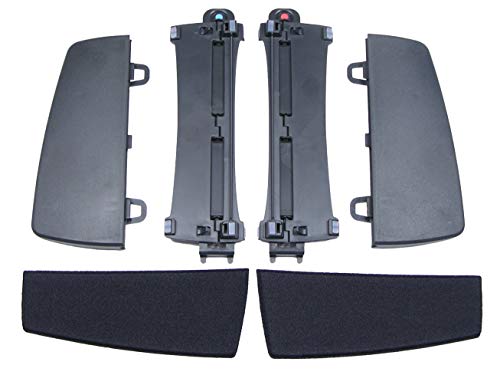- Features
- Description
- Similar Items
REDUCE FOREARM STRAIN FOR MAXIMUM ERGONOMICS: Conventional flat keyboards force you type with your palms facing down. This harmful posture puts pressure on the forearm muscles and tissues which reduces blood circulation and can lead to fatigue and repetitive strain injuries ("RSI") like carpal tunnel syndrome. Attach the VIP3 accessory to your Freestyle2 keyboard to elevate your thumbs for a significantly more comfortable and healthier typing position.
INTEGRATED PALM SUPPORTS WITH CUSHIONED PALM PADS: The VIP3 tenting accessory is designed for those typists who prefer the additional support of the padded palm rests. Choose the V3 model for tenting without Palm Supports
THREE ADJUSTABLE HEIGHTS TO CHOOSE FROM: Ergonomics is all about finding the right configuration for your body type and workstation. The VIP3 kit lets you choose from 5, 10, and 15 degree tenting heights for maximum comfort and easy reproducibility.
WHAT'S IN THE BOX: Left and Right v-Lifters, Left and Right Palm Supports, Left and Right Adhesive Palm Pads. KEYBOARD NOT INCLUDED.
COMPATIBLE WITH ALL FREESTYLE2 MODEL KEYBOARDS: The VIP3 (AC820) is compatible with all KB800 series keyboards from Kinesis. Not compatible with Freestyle Pro, or Freestyle Edge which have their own corresponding tenting accessories.
INTEGRATED PALM SUPPORTS WITH CUSHIONED PALM PADS: The VIP3 tenting accessory is designed for those typists who prefer the additional support of the padded palm rests. Choose the V3 model for tenting without Palm Supports
THREE ADJUSTABLE HEIGHTS TO CHOOSE FROM: Ergonomics is all about finding the right configuration for your body type and workstation. The VIP3 kit lets you choose from 5, 10, and 15 degree tenting heights for maximum comfort and easy reproducibility.
WHAT'S IN THE BOX: Left and Right v-Lifters, Left and Right Palm Supports, Left and Right Adhesive Palm Pads. KEYBOARD NOT INCLUDED.
COMPATIBLE WITH ALL FREESTYLE2 MODEL KEYBOARDS: The VIP3 (AC820) is compatible with all KB800 series keyboards from Kinesis. Not compatible with Freestyle Pro, or Freestyle Edge which have their own corresponding tenting accessories.
Binding:
Personal ComputersBrand:
KINESISEAN:
0607998720011Label:
KinesisManufacturer:
KinesisModel:
KIN-FS-VIP3Size:
Warranty:
The VIP3 accessory kit attaches easily to the base of any Freestyle2 Keyboard allowing quick and reproducible slope settings of 5, 10 and 15 degrees. Unlike traditional flat keyboards that force your forearms and wrists into a pronated position, the Freestyle2 with VIP3 supports 3 adjustable tenting heights to greatly reduce pronation for greater comfort and productivity. Pronation in the forearm and wrist occur in a typing position as the palms of your hand are turned face down and is parallel with the flat surface of the desk or floor. The majority of this turning involves the rotation of both forearm bones (the ulna and radius). Sustained pronation increases pressure on the forearm muscles and surrounding tissues and reduces blood circulation which can lead to fatigue and injury. Research demonstrates that a moderate elevation of the thumb side of the hand dramatically reduces this type of stress.






